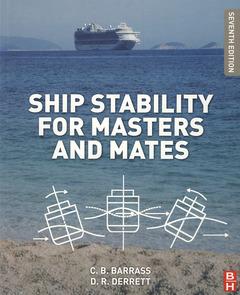Description
Ship Stability for Masters and Mates (7th Ed.)
Authors: Barrass Bryan, Derrett Capt D R
Language: English
Subjects for Ship Stability for Masters and Mates:
Keywords
ship strength; squat; trim; materials stresses; ship motion; Simpsons Rules; calibration book
75.66 €
In Print (Delivery period: 14 days).
Add to cart584 p. · 19x23.3 cm · Paperback
Description
/li>Contents
/li>Readership
/li>Biography
/li>Comment
/li>
Practising marine engineers, naval architects and ship operations personnel; Consulting marine engineers; Marine engineering students on courses in ship stability and related areas; Students on professional certification / vocational courses covering the above.
In 1993 he retired from full-time work. He became a visiting Lecturer and has written seven books involving Ship Stability, Ship Design & Ship Performance and Ship Squat & Interaction. His interest in Ship Squat began in April 1972, starting on research for his Ph.D. degree.
He has worked with many national & international Port Authorities. They include the PLA, Milford Haven PA, Liverpool PA, Humberside PA, Tyne PA, Truro PA, Newhaven PA, Bordeaux PA, Klaipeda PA, Nantes PA and Hamburg PA.
Dr Barrass has supplied Ship Squat and Interaction information to 22 countries worldwide. He has lectured at a great number of UK Universities and has advised many Ship-owners on the above listed Specialist topics.
- Updated throughout to include new shipping industry developments and regulations, with 9 new chapters, the latest ship stability datasheets, and sample exam questions
- Provides a comprehensive introduction to all aspects of ship stability and ship strength, squat, interaction and trim, materials stresses and forces
- Concepts are supported with numerous worked examples, clear diagrams, graphs and equations to assist with understanding and application of this critical subject
These books may interest you

Ship Construction 75.66 €



